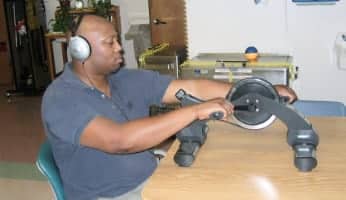Setting IM Records- Can She Be Beat?

Home - Testimonials - Adult Testimonials - Setting IM Records- Can She Be Beat?

Setting IM Records- Can She Be Beat?
After being screened for elective gall bladder surgery, Virginia’s doctors discovered she had problems with her heart and she quickly underwent a triple bypass surgery. Complications from the surgery included an inability to get an adequate blood supply to her right leg. At the age of 63, she underwent surgery to have her right leg amputated below the knee. She worked with therapists at Kansas Rehab Hospital to learn to use her new right lower extremity prosthesis. Virginia was gaining confidence in her ability to manage at home with a rolling walker.
Seven months later, Virginia was faced with the amputation of her left leg because of osteomyelitis. This time, her pre-prosthetic training incorporated Interactive Metronome® exercises.
The Interactive Metronome® (IM) program provides a structured, goal-oriented process that challenges the client to synchronize a range of hand and foot exercises to a precise computer-generated reference tone heard through headphones. The client attempts to match the rhythmic beat with repetitive motor actions. A patented auditory-visual guidance system provides immediate feedback measured in milliseconds, and a score is provided.
Virginia’s inpatient hospitalization included days spent in the skilled nursing section of Kansas Rehab Hospital to address the healing time required for pressure ulcers and her residual limb. She requested that her Occupational Therapy sessions included IM exercises on the days that her physiatrist allowed her to spend time “up” in her wheelchair. Virginia’s upper and lower body IM exercises were modified because of pressure ulcers limiting her sitting time. Because of diabetic retinopathy, treatment room lights were dimmed so that Virginia could discriminate the visual feedback on the computer screen. Although she could not read the millisecond feedback, she could easily discriminate green, red and yellow. Despite these challenges, Virginia established a “facility record” for achieving the greatest number of consecutive “right on” responses using both hands!
Upper and lower body IM exercises were performed at various tempos to support her gait training activities with her physical therapist. OT IM sessions also focused on:
- Maintaining her standing balance using her single RLE prosthesis and walker
- Standing posture
- Sit to stand transitions
- Alternating upper and lower body movements
- Integrating LLE into IM exercises by placing the hand trigger under her left residual limb
By the time Virginia’s new prosthesis arrived, the pressure ulcers were significantly improved. It was no longer necessary to limit her “sitting” time. Her inpatient stay was extended to include prosthetic training with PT and OT. IM exercises were performed while standing with the walker. Virginia was discharged to go home, using her walker for short distances in her house (with supervision) and using the wheelchair.
She began outpatient PT and OT (IM) sessions on an outpatient basis. IM exercises made it easier for Virginia to identify “friction areas” which could be addressed by her prosthetist and improve her standing balance and endurance.
Virginia was able to successfully achieve her goals:
1. Eliminate the use of the wheelchair while performing routine tasks at home.
2. Resuming participating in enjoyable activities like meeting friends to play cards and spending time with her children and grandchildren at their homes.
Virginia has willingly shared her rehab experiences with many others. She encourages others who are new amputees and challenges everyone that uses the Interactive Metronome® exercises to try to beat her record!
Karen Farron, OTR/L, MHS, MIMC






